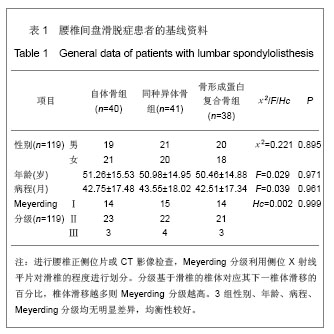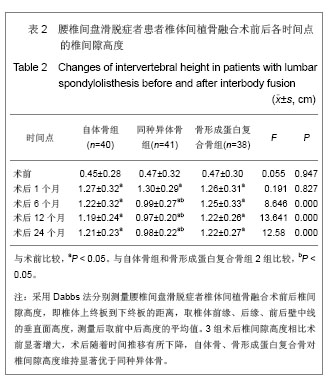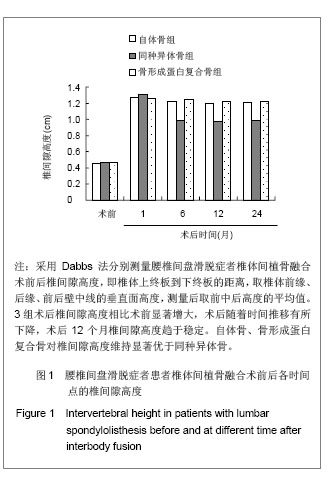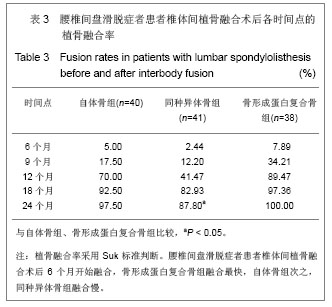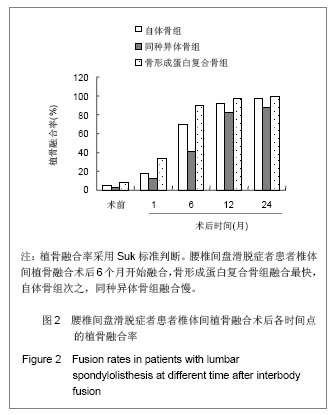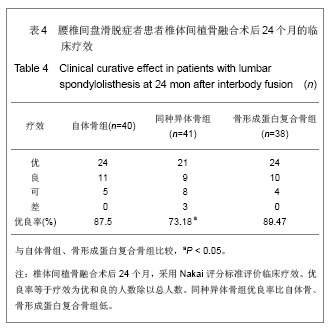| [1]Marchi L, Oliveira L, Coutinho E, et al. Results and complications after 2-level axial lumbar interbody fusion with a minimum 2-year follow-up. J Neurosurg Spine. 2012;17(3): 187-192.[2]Smoljanovic T, Dokuzovic S, Bojanic I. Osteoinductive bone graft substitutes for lumbar fusion. J Neurosurg Spine. 2010; 13(3):407-409. [3]Agarwal R, Williams K, Umscheid CA, et al. Osteoinductive bone graft substitutes for lumbar fusion: a systematic review. J Neurosurg Spine. 2009;11(6):729-740. [4]König MA, Boszczyk BM. Limited access surgery for 360 degrees in-situ fusion in a dysraphic patient with high-grade spondylolisthesis. Eur Spine J. 2012;21(3):390-395.[5]Chrastil J, Patel AA. Complications associated with posterior and transforaminal lumbar interbody fusion.J Am Acad Orthop Surg. 2012;20(5):283-291.[6]Schmid R, Lindtner RA, Lill M, et al. Combined posteroanterior fusion versus transforaminal lumbar interbody fusion (TLIF) in thoracolumbar burst fractures. Injury. 2012;43(4):475-479. [7]Wei C, Yang HL, Wang GL, et al. Zhongguo Zuzhi Gongcheng Yanjiu yu Linchuang Kangfu. 2009;13(52):10274-10278.魏超,杨惠林,王根林,等.椎间融合与环周融合结合椎弓根钉内固定置入治疗成人腰椎滑脱:效果优于后外侧融合吗[J]?中国组织工程研究与临床康复,2009,13 (52):10274-10278.[8]Jensen SS, Terheyden H. Bone augmentation procedures in localized defects in the alveolar ridge: clinical results with different bone grafts and bone-substitute materials. Int J Oral Maxillofac Implants. 2009;24 Suppl:218-236.[9]Khojasteh A, Behnia H, Shayesteh YS, et al. Localized bone augmentation with cortical bone blocks tented over different particulate bone substitutes: a retrospective study. Int J Oral Maxillofac Implants. 2012;27(6):1481-1493.[10]Bose S, Roy M, Bandyopadhyay A. Recent advances in bone tissue engineering scaffolds. Trends Biotechnol. 2012;30(10): 546-554. [11]Zimmermann G, Moghaddam A. Allograft bone matrix versus synthetic bone graft substitutes. Injury. 2011;42 Suppl 2:S16-21. [12]Sun Y, Meng QF, Gao ZH, et al. Yingxiang Zhenduan yu Jieru Fangshexue. 2007;16(3):135-137.孙洋,孟悛非,高振华,等.椎间盘和椎间隙的影像学对比观察[J].影像诊断与介入放射学,2007,16(3):135-137.[13]Suk SI, Lee CK, Kim WJ, et al. Adding posterior lumbar interbody fusion to pedicle screw fixation and posterolateral fusion after decompression in spondylolytic spondylolisthesis. Spine. 1997;22(2):210-219;discussion 219-220.[14]Zhang JG, Ding WY, Shen YY. Jizhu Waike Zazhi. 2011;9(4): 232-235.张剑刚,丁文元,申摇勇.经椎间孔椎体间融合术治疗复发性腰椎椎间盘突出症的疗效分析[J].脊柱外科杂志,2011,9(4):232-235. [15]Wang LL, Jin GL, Ren LL, et al. Zhongguo Zuzhi Gongcheng Yanjiu yu Linchuang Kangfu. 2011;15(16):2885-2888.王磊磊,金格勒,任龙龙,等.不同植骨材料在腰椎融合过程中的应用及转化生长因子β的表达[J].中国组织工程研究与临床康复, 2011,15(16):2885-2888.[16]Yang Y, Jin GL,Tang ZZ, et al. Zhonghua Shiyan Waike Zazhi. 2010;27(2):245-247.杨毅,金格勒,唐周舟,等.复合骨在兔腰椎融合过程中相关基因表达调控的影响[J].中华实验外科杂志,2010,27(2):245-247.[17]Guo CT, Zhou Q, Dai F, et al. Disan Junyi Daxue Xuebao. 2010;32(17):1875-1879.郭从涛,周强,代飞,等.异体腓骨环椎间融合器在腰椎融合术中的效果分析[J].第三军医大学学报,2010,32(17):1875-1879.[18]Zhang HB, Wang YS,JIA SM, et al. Zhongguo Jiaoxing Waike Zazhi. 2008;16(9):657-659.张海波,王义生,贾思明,等.后路环状融合术在腰椎滑脱症外科手术中的应用[J].中国矫形外科杂志,2008,16(9):657-659.[19]Yin P, Liu XZ, Wu YP, et al. Zhongguo Xiufu Chongjian Waike Zazhi. 2012;26(7):778-782.殷鹏,刘秀珍,吴延平,等.不同植骨材料在退变性腰椎病脊柱融合术中的应用与疗效比较[J].中国修复重建外科杂志, 2012, 26(7): 778-782.[20]Ito Z, Matsuyama Y, Sakai Y, et al. Bone union rate with autologous iliac bone versus local bone graft in posterior lumbar interbody fusion. Spine (Phila Pa 1976). 2010;35(21): E1101-E1105. [21]Liao SS, Guan K, Cui FZ, et al. Lumbar spinal fusion with a mineralized collagen matrix and rhBMP-2 in a rabbit model. Spine (Phila Pa 1976). 2003;28(17):1954-1960.[22]Luo J, Sun MH, Kang Q, et al. Gene therapy for bone regeneration. Curr Gene Ther. 2005;5(2):167-179.[23]Kai T, Shao-qing G, Geng-ting D. In vivo evaluation of bone marrow stromal-derived osteoblasts-porous calcium phosphate ceramic composites as bone graft substitute for lumbar intervertebral spinal fusion. Spine (Phila Pa 1976). 2003;28(15):1653-1658.[24]Ma X, Wu, XM, Hu YY, et al. Intervertebral Spinal Fusion Using a RP-based PLGA/TCP/bBMP Biomimetic Grafting Material. J Bioact Compat Pol. 2009;24(1):146-157.[25]Zou X, Zou L, Foldager C, et al. Different mechanisms of spinal fusion using equine bone protein extract, rhBMP-2 and autograft during the process of anterior lumbar interbody fusion. Biomaterials. 2009;30(6):991-1004.[26]Fei QM, Jiang XX, Chen TY, et al. Changes with age and the effect of recombinant human BMP-2 on proteoglycan and collagen gene expression in rabbit anulus fibrosus cells. Acta Biochim Biophys Sin (Shanghai). 2006;38(11):773-779.[27]Kong MH, Do DH, Miyazaki M, et al. Rabbit Model for in vivo Study of Intervertebral Disc Degeneration and Regeneration. J Korean Neurosurg Soc. 2008;44(5):327-333.[28]Gu Y, Chen L, Yang HL, et al. Evaluation of an injectable silk fibroin enhanced calcium phosphate cement loaded with human recombinant bone morphogenetic protein-2 in ovine lumbar interbody fusion. J Biomed Mater Res A. 2011;97(2): 177-185.[29]Ma X, Hu YY, Lv R, et al. Multilevel Posterior Lumbar Interlaminar Fusion in Rabbits Using Bovine Bone Protein Extract Delivered by a RP-synthesized 3D Biopolymer Construct. J Bioact Compat Pol. 2010;25(5):513-526.[30]Wang XY, Guo X, Qu SX, et al. Temporal and spatial CGRP innervation in recombinant human bone morphogenetic protein induced spinal fusion in rabbits. Spine (Phila Pa 1976). 2009;34(22):2363-2368. |
